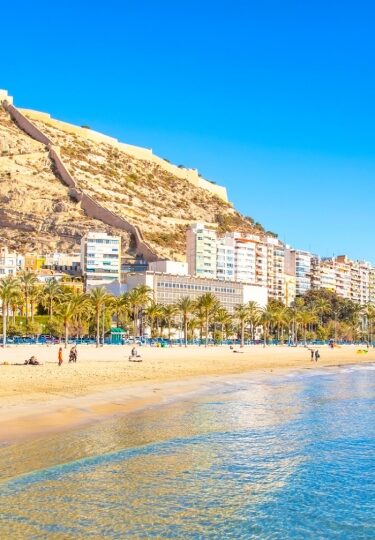Lying on Spain’s sunny east coast in the middle of the Costa Blanca, Alicante offers plenty to do for culture- and nature-hungry travelers.
Gastronomy is big in Alicante, with Mediterranean-fresh produce filling the city’s Central Market and lining the tables of tapas bars. Alicante also offers a string of golden beaches and pretty coves for visitors to enjoy.
Many of the best things to do in Alicante are central to the city. You could take shade in sun-dappled squares, peek inside centuries-old churches, and peruse the city’s old and new museums, most found near the old town, Barrio de la Santa Cruz.
Discover the best things to do in Alicante on your next Spanish getaway.
Stroll La Explanada de España

La Explanada de España
Enjoy the warm Mediterranean breeze as you stroll along La Explanada de España, Alicante’s palm tree-lined promenade.
Adorned with a wave-design mosaic floor, this picturesque spot perfectly combines with a walk around the city’s yacht-filled marina or a relaxing stint on the shore of Playa del Postiguet.
During summer, you might catch the Alicante Craft Fair, which stretches out on the promenade, with vendors selling leather goods, handmade jewelry, nougat, and other gourmet sweet treats.

Casa Carbonell
Look out for the gleaming Casa Carbonell, a landmark Beaux Arts–inspired building dating from the 1920s.
You’ll find plenty of sun-dappled spots to enjoy a coffee, glass of wine, or bite to eat on La Explanada de España, with everything from tapas to chocolate-covered churros and ice-cream available.
Wander Barrio de la Santa Cruz
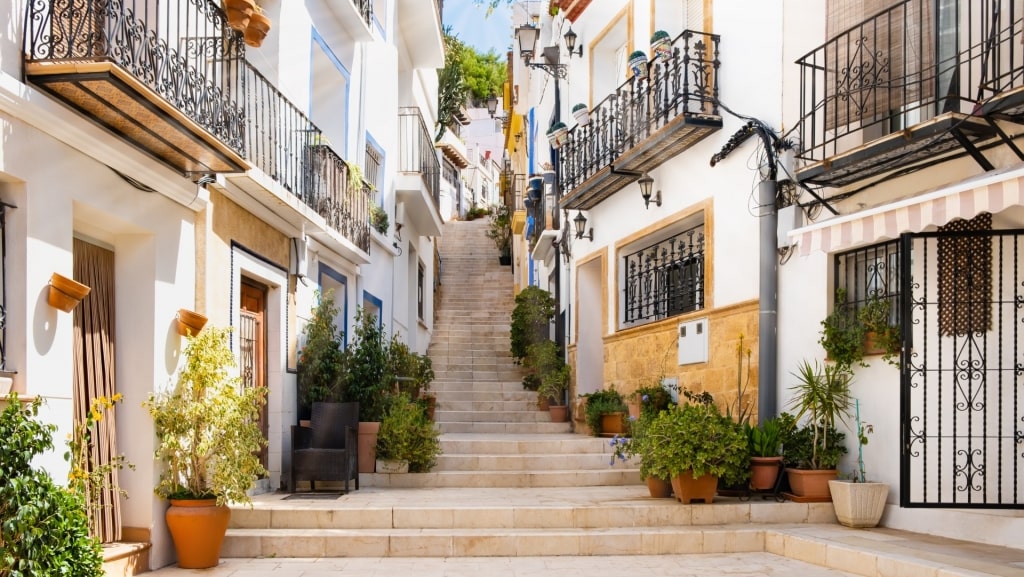
Barrio de la Santa Cruz
Barrio de la Santa Cruz is the eye-catching old pocket of Alicante located on the southwest slope of Mount Benacantil.
Barrio de la Santa Cruz’s tapered streets are steep, scenic, and romantic, lined with soft-hued buildings adorned with balconies.
Handsome squares with tall palm trees and restaurants with outdoor seating are dotted around the old district, including the prime people-watching spot of Plaça de la Santissima Faç.

San Nicolás Co-Cathedral
The old town boasts some of Alicante’s most beautiful architecture, including the 1616-built San Nicolás Co-Cathedral. Designed in the late-Spanish renaissance style on the site of a medieval temple, the church is shaped like a cross with a 148-foot blue-domed roof and a separate bell tower.
Nearby, at the Gravina Fine Arts Museum within the 18th-century Gravina Palace, browse art collections created in Alicante ranging from the Middle Ages to the early 20th century.
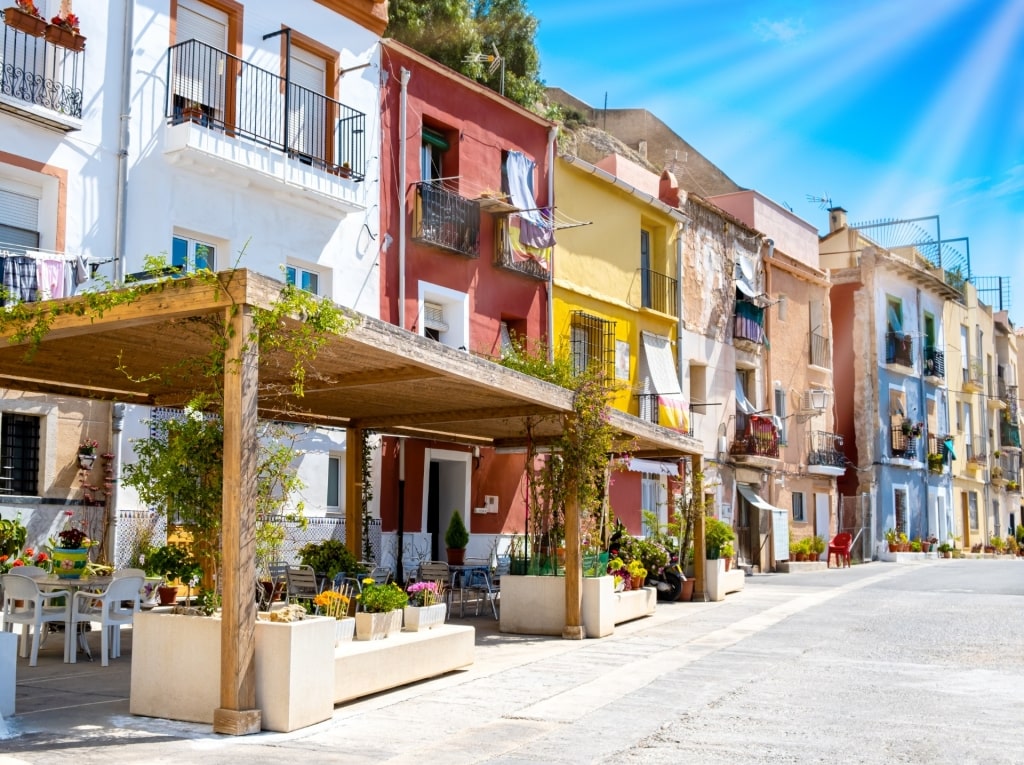
Barrio de la Santa Cruz
Barrio de la Santa Cruz is one of the best places to shop and dine in Alicante, with upmarket boutiques nestled among the many restaurants and tapas bars that Spain is famous for.
Try La Tasca Del Barrio on Carrer Llauradors for the fried Andalusian bay squid, wild mushroom with truffle croquette, and squid-ink rice with clams.
Visit MACA, the Alicante Museum of Contemporary Art
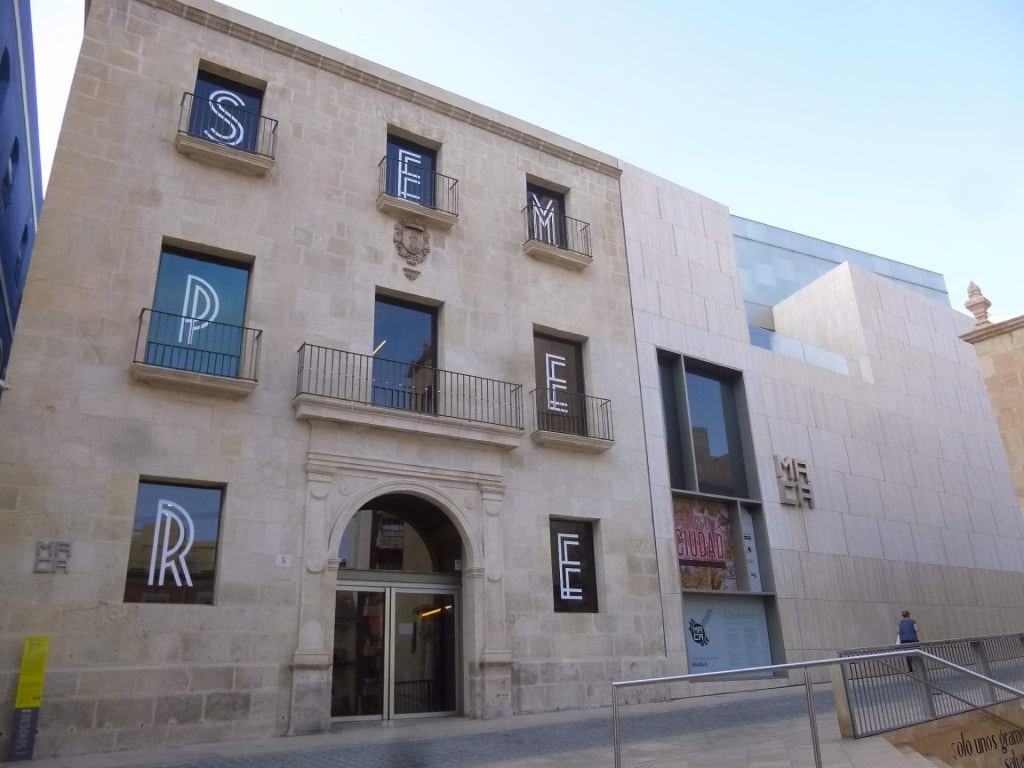
Alicante Museum of Contemporary Art Photo by Zarateman on Wikimedia Commons, licensed under CC0 1.0
Visit the Alicante Museum of Contemporary Art next to the grand Basilica of Santa Maria for its thrilling collection of modern 20th-century Spanish art.
The museum was established in 1977 after the local artist Eusebio Sempere donated his collection of works to the city, which can now be viewed inside the gallery. There are three permanent collections to explore, consisting of around 800 paintings, sculptures, drawings, graphic works, lithographs, and engravings.
Admire the works by some of Spain’s most prominent 20th-century artists—Sempere, Picasso, Dalí, and Miró—on the stark, white walls.
Gaze at the Basilica of Santa Maria
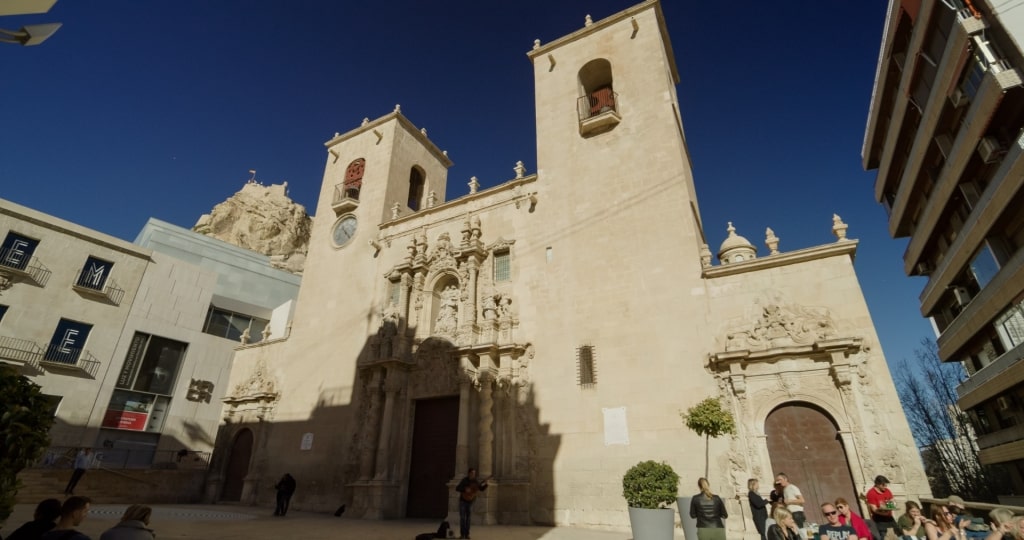
Basilica of Santa Maria
One of the best things to do in Alicante is to gaze at the extraordinary Basilica of Santa Maria, the oldest church in the city, on the edge of the old district.
Constructed in the 14th century on the site of the city’s largest mosque, the Basilica of Santa Maria was rebuilt in the 16th century following a devastating fire.
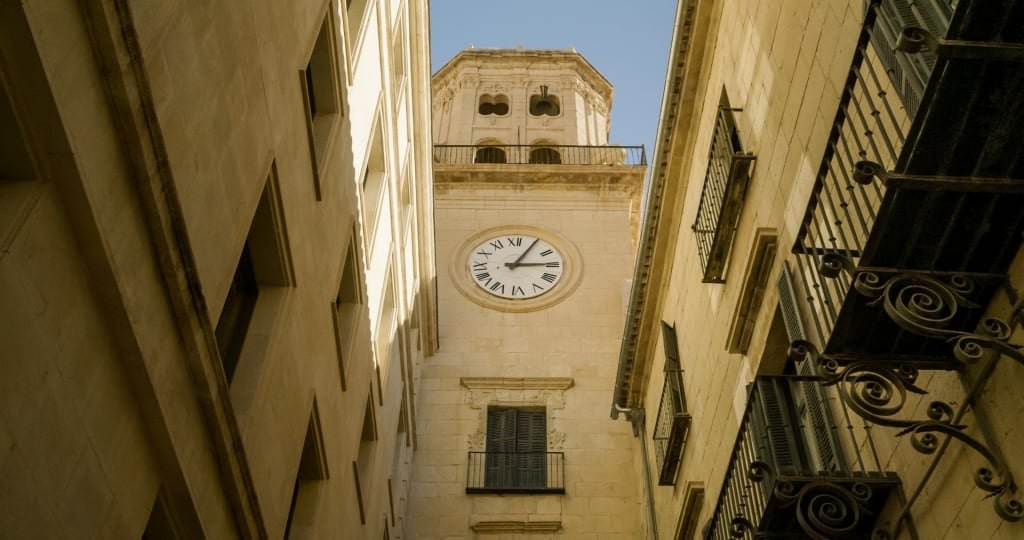
Basilica of Santa Maria
The basilica features two towers and displays both gothic and baroque architecture, including an extravagant facade of the main entrance seen from Plaza Santa Maria. Step inside the entryway, passing ornate sculptures by Juan Bautista Borja, into the tall, single nave.
Marvel at the 18th-century Rococo main altar, the enormous 16th-century Carrara marble font, and the 17th-century Valencian Baroque organ inside the Chapter House.
Lose Yourself in the Palm Grove of Elche
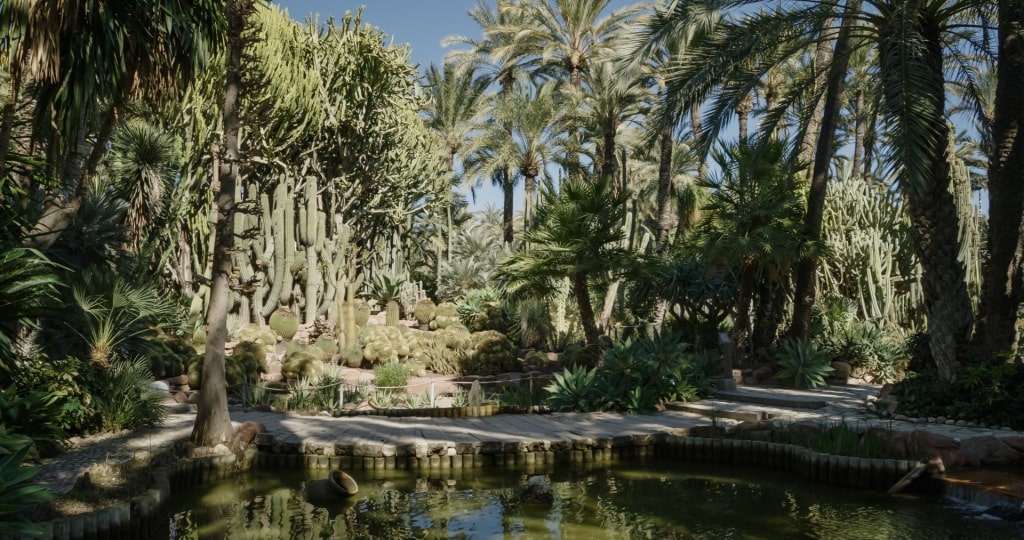
Elche
Located in the ancient city of Elche, just outside of Alicante, this alluring UNESCO World Heritage Site is the largest palm grove in Europe.
Over 200,000 luscious palms fill this gargantuan grove. They were first laid out to form vast orchards—including the Municipal Park, Huerto de Abajo, Huerto del Cura, and Huerto del Chocolatero—during the region’s Muslim period.

Molí del Real, Elche
Wander through the leafy Municipal Park to stumble upon the 18th-century Molí del Real flour mill. In operation until the 1940s, the mill’s western façade features 12 Renaissance-style arches. There’s a central café with outdoor seating, fountains, and small ponds with ducks.
While towering palm trees dominate the park, you’ll also find blushing bougainvillea, fig trees, rosewoods, banana trees, and the rare tulip tree from Gabon.
Also in Elche, you could step inside the peachy-pastel Palmeral Museum in the Huerto de San Plácido Garden, which explores the history of the Palm Grove.
Marvel at Villena’s Atalaya Castle
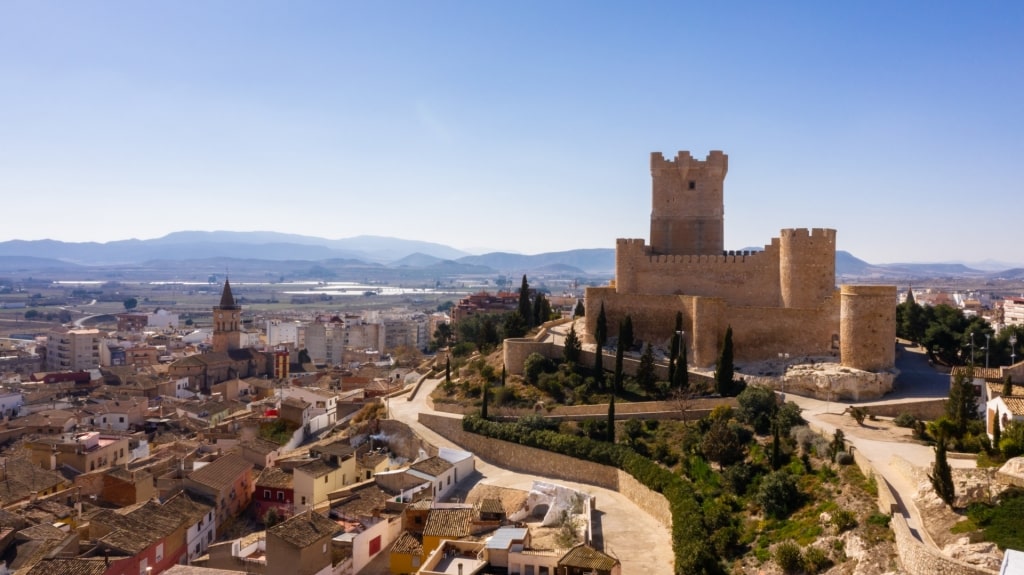
Atalaya Castle
The stately Atalaya Castle looms over the ancient city of Villena, a short distance northwest of Alicante.
Built on a hill by the Almohad empire in the late 12th century as a refuge for Villena’s Muslim residents, Atalaya is one of the most beautiful places in Spain.
Weave through Villena’s handsome narrow streets to arrive at the imposing medieval fortress. There’s a double curtain wall—the inner wall taller than the outer wall—with 12 defensive towers and a square keep.
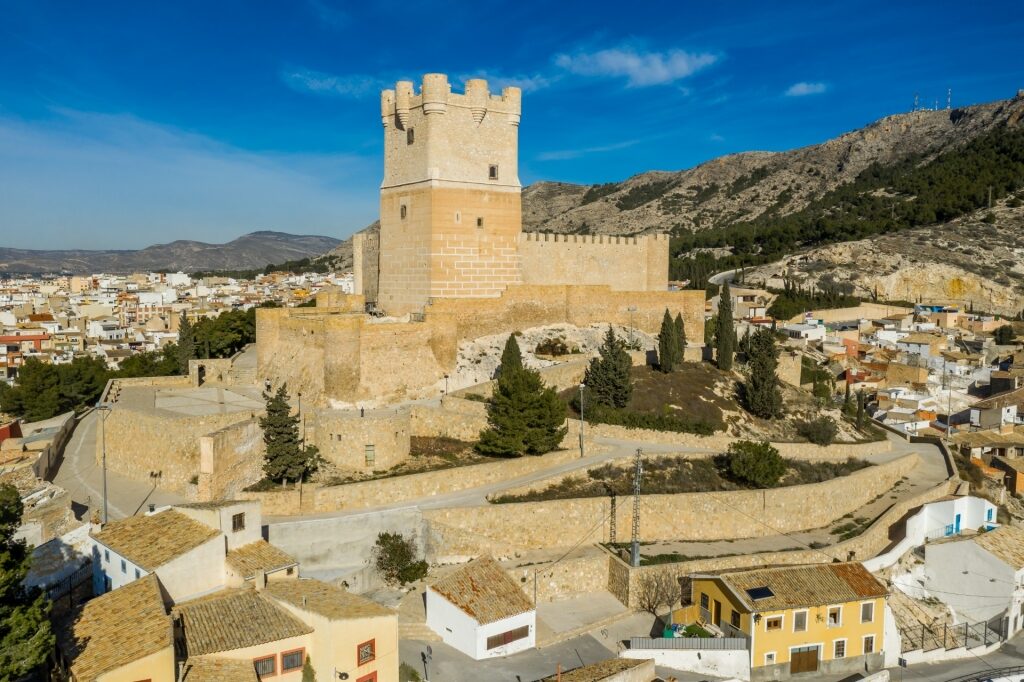
Atalaya Castle
Gaze at magnificent panoramic views as you climb the three-story keep. After exploring the Spanish castle, set aside some time to wander Villena’s atmospheric winding lanes.

Santa María Gothic Church
Stop by the 15th-century Santiago Apóstol and 16th-century Santa María Gothic churches.
Explore artifacts from the Late Bronze Age at the Municipal Museum of Archaeology, located within Villena’s City Hall, and admire the colorful balconied buildings in Plaza Santiago and Plaza Santa Maria.
There are plenty of cafés, bars, and restaurants dotted around the ancient town. Try Restaurante La Teja Azul, tucked away to the northwest of the castle. The rice with monkfish, shrimp, and green artichoke is divine.
Graze at the Central Market of Alicante
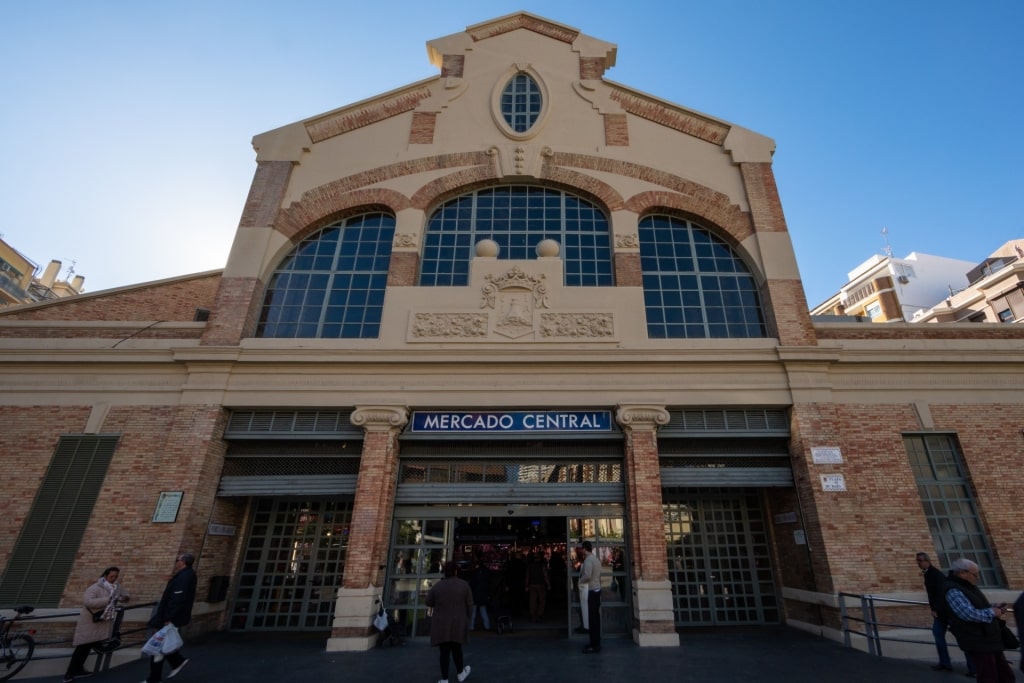
Central Market of Alicante
The block-wide Central Market of Alicante is one of the best places to delve into the region’s smorgasbord of gourmet produce.
Set in a two-story early 20th-century building, the Central Market is lined with vendors selling fruits, vegetables, fish, meat, cured ham, dairy, and olive oil. Spanish wine, jars of olives, candy, and jellies fill shelves, while wedges of juicy watermelon and bunches of plump grapes hang from stalls.
Drop by Jorge Ramos for all of your charcuterie needs, Salzillo for outstanding coffee, spices, and herbs, and Juan Lloret for delicious cheeses.
You’ll also find a selection of tapas bars inside the Central Market. Perch on a bar stool to savor plates of life-changing gamba roja (red shrimp), tortilla de patatas (Spanish omelet), and patatas bravas (spicy potatoes).
Unwind on Alicante’s White Beaches
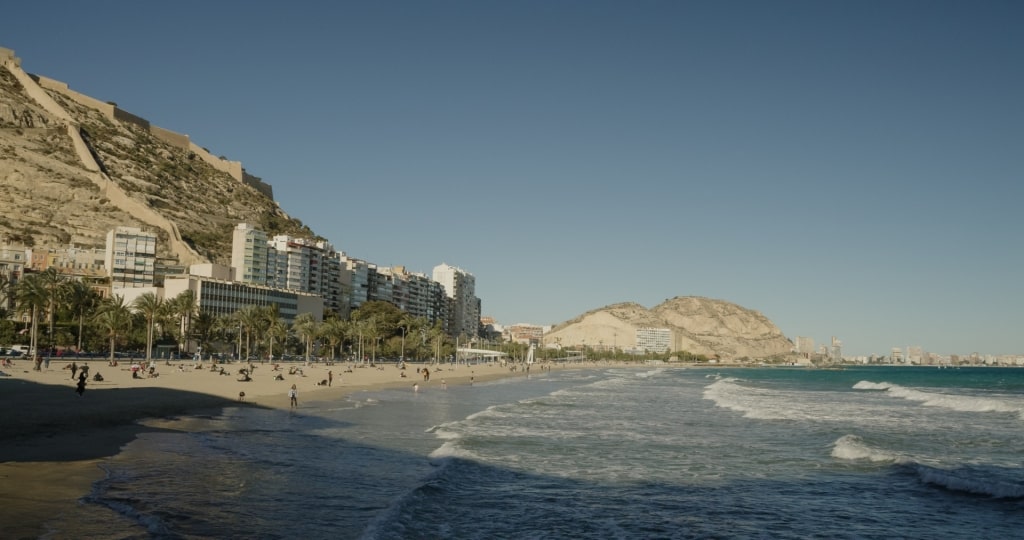
Playa del Postiguet
A string of long, sultry sands and heart-stopping coves make up the Costa Blanca’s enviable shoreline, making a trip to the beach one of the best things to do in Alicante.
Flanked by palm trees and Santa Bárbara Castle, Playa del Postiguet is unbeaten for its central location and swathe of powdery sand.
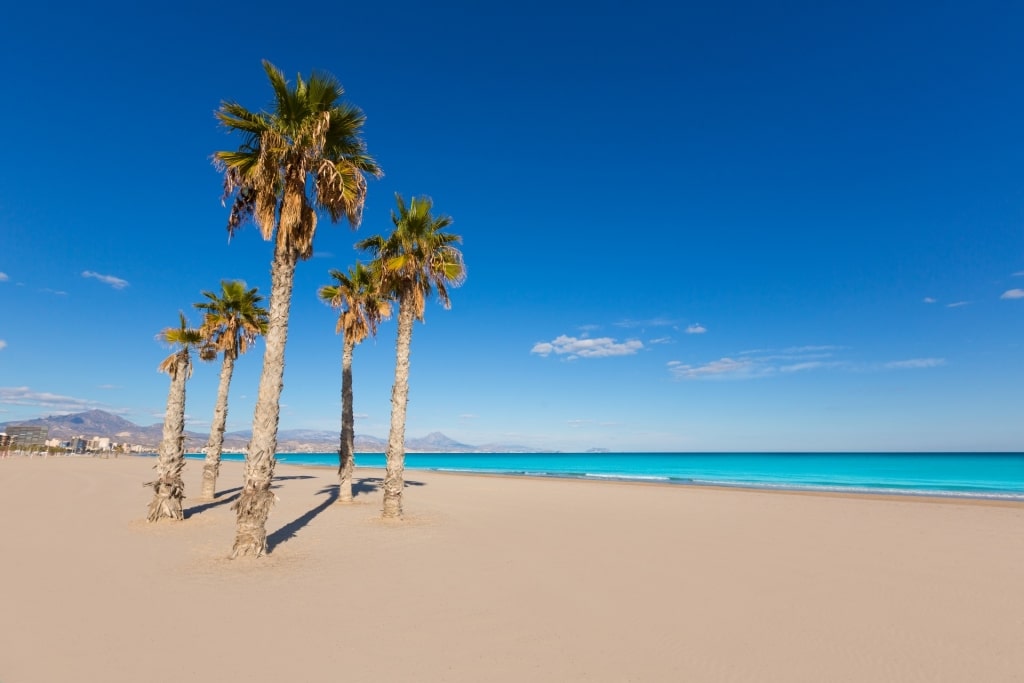
Playa de San Juan
Playa de San Juan, one of Spain’s best beaches, leads onto Playa de Mutxavista, forming a sprawling palm tree-lined shoreline with sun loungers and umbrellas, watersports, and a buzzy promenade.
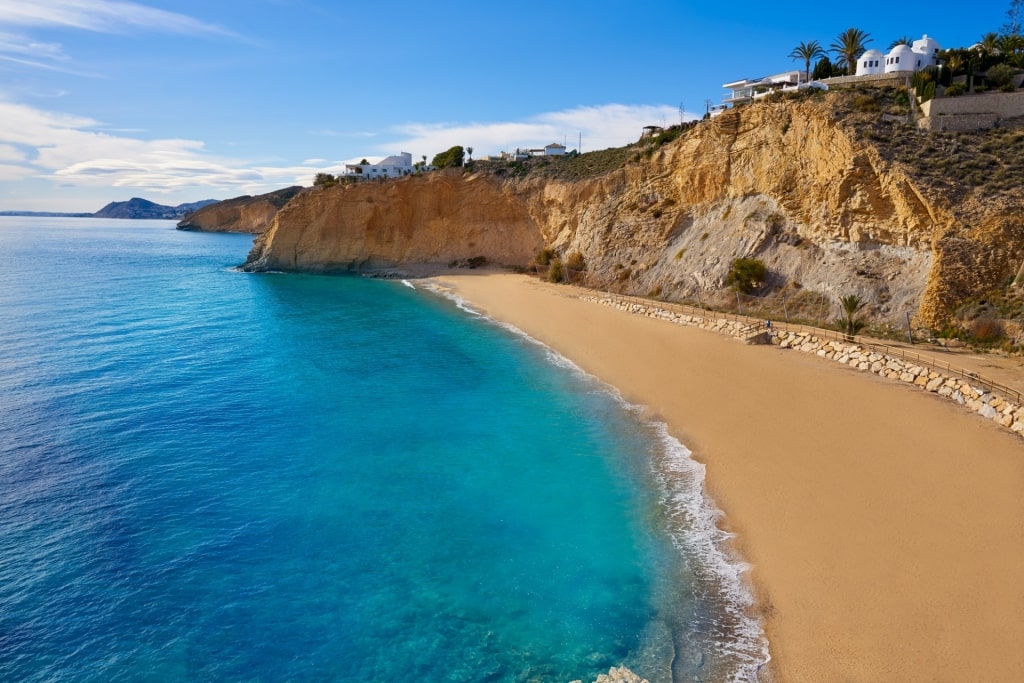
Playa del Bol Nou
Northeast of the city, Playa del Bol Nou is a secluded cove with sea caves and clear aquamarine water, flanked by tall cliffs.
Embark on a Boat Trip to Isla de Tabarca
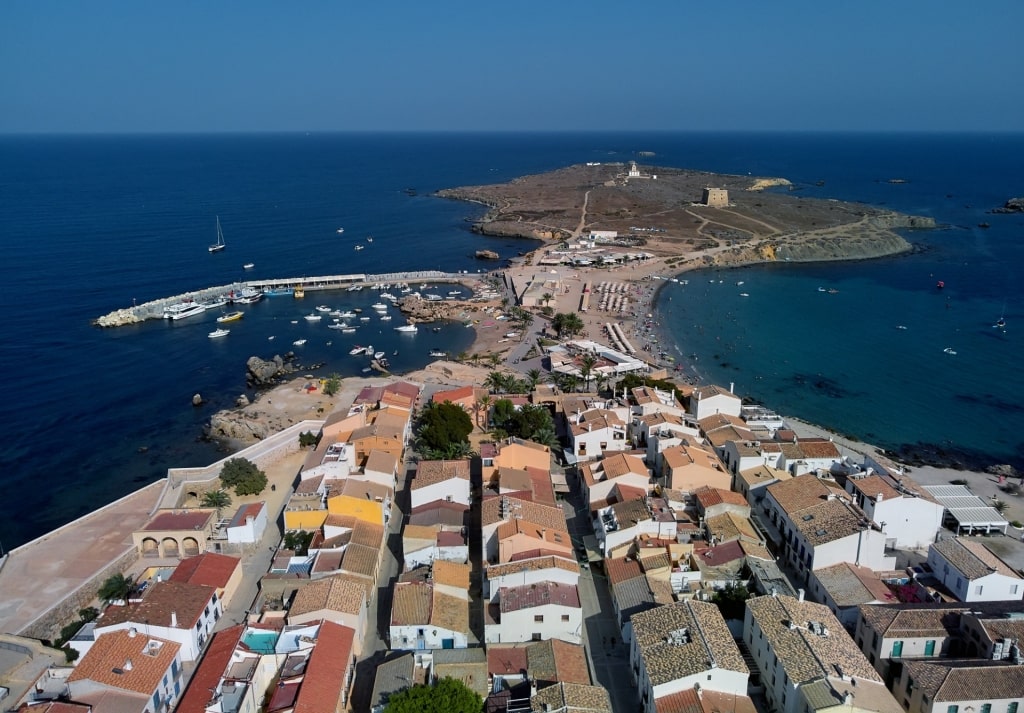
Isla de Tabarca
Tabarca is a little-known islet, part of a four-island archipelago off the Valencian coast, just south of Alicante and once occupied by Berber pirates. King Carlos III ordered the construction of a fort and town on Tabarca in the 18th century.
You can walk from the westernmost to the easternmost point of the island in under 30 minutes, though you’ll want to spend time exploring the pretty whitewashed old town.
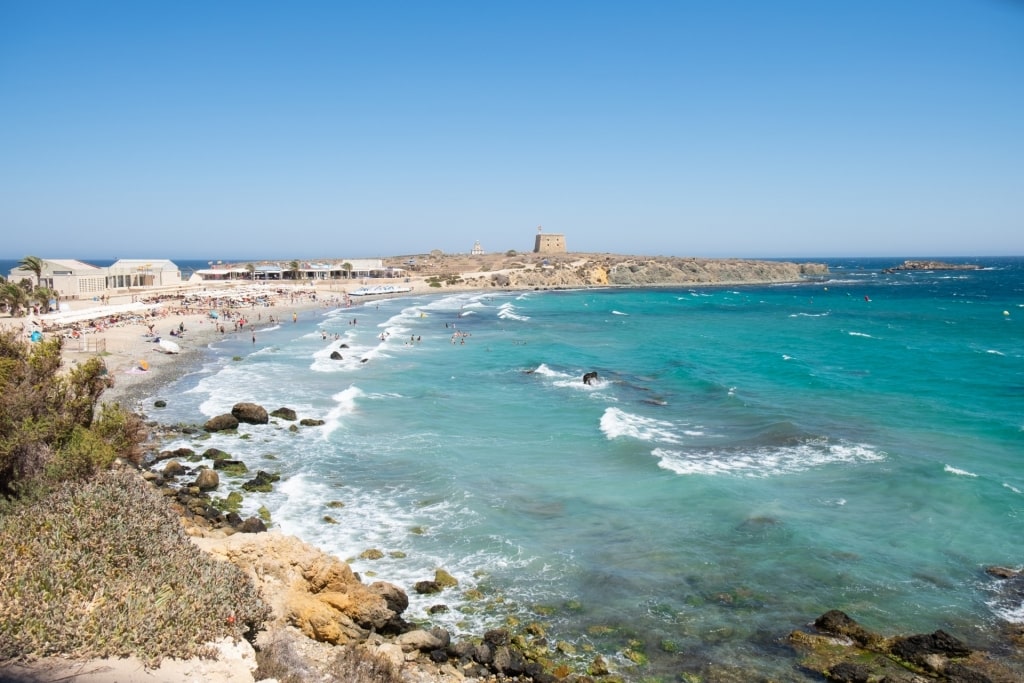
Platja de Tabarca, Isla de Tabarca
Tabarca’s main beach, Platja de Tabarca, is perfect for snorkeling. The waters around the island are part of a designated Mediterranean Marine Reserve—all crystal clear and teeming with marine life. Pack swimwear, a towel, and snorkel gear to go in search of barracudas, stingrays, lobsters, and moray eels.
Try a Tabarca specialty—grouper meatballs, lobster and rice, or caldero, a fish dish served with garlicky tomato rice or sliced potato—at one of the island’s quaint restaurants.
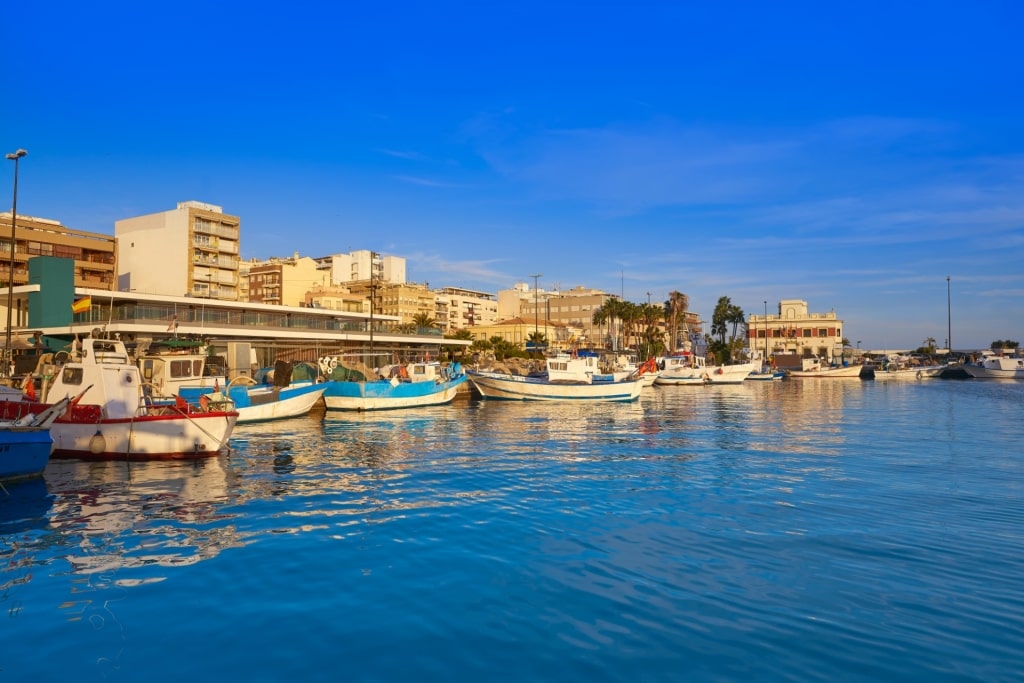
Santa Pola Port
To get to Isla de Tabarca, take a water taxi from Santa Pola, a suburb south of Alicante. A service operates every 30 minutes during summer, with the crossing taking 20 minutes.
A boat and catamaran service also operates from Alicante’s marina, though it takes longer and is less frequent. Some boat trips from the mainland incorporate snorkeling into their program.
Admire the Seaside Town of Villajoyosa
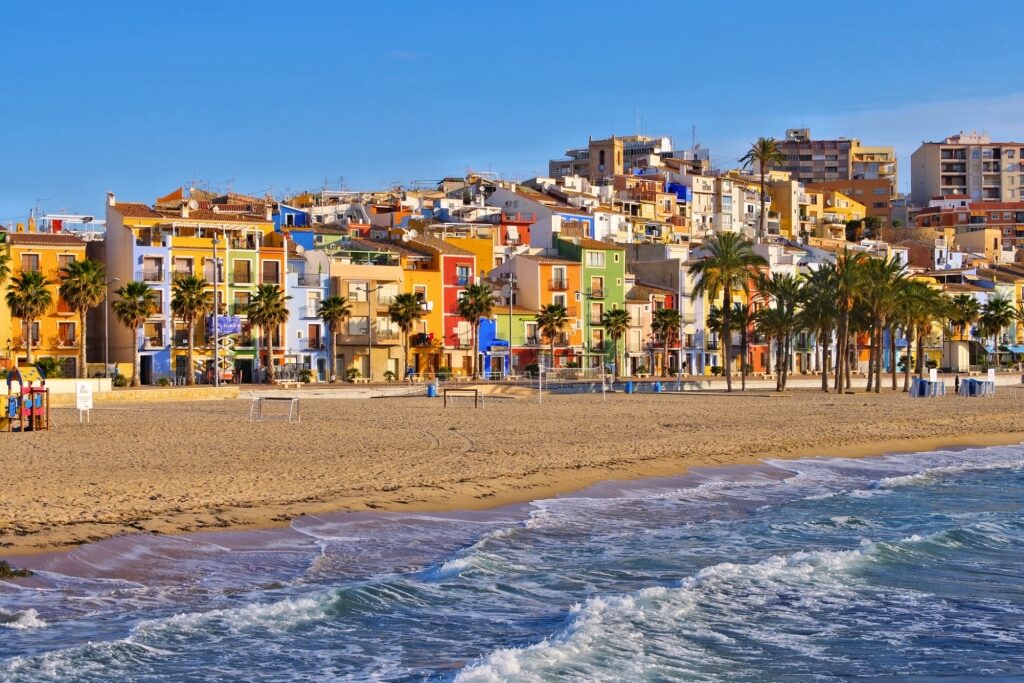
Villajoyosa
Framed by the Sierra de Aitana, Villajoyosa is a postcard seaside town a short distance north of Alicante.
This former fishing village is known for its photogenic seafront of brightly-colored houses. Wander through the backstreets, where the same vibrant theme continues. Washing hanging from balconies three and four stories high only adds to the charm of this enchanting town.
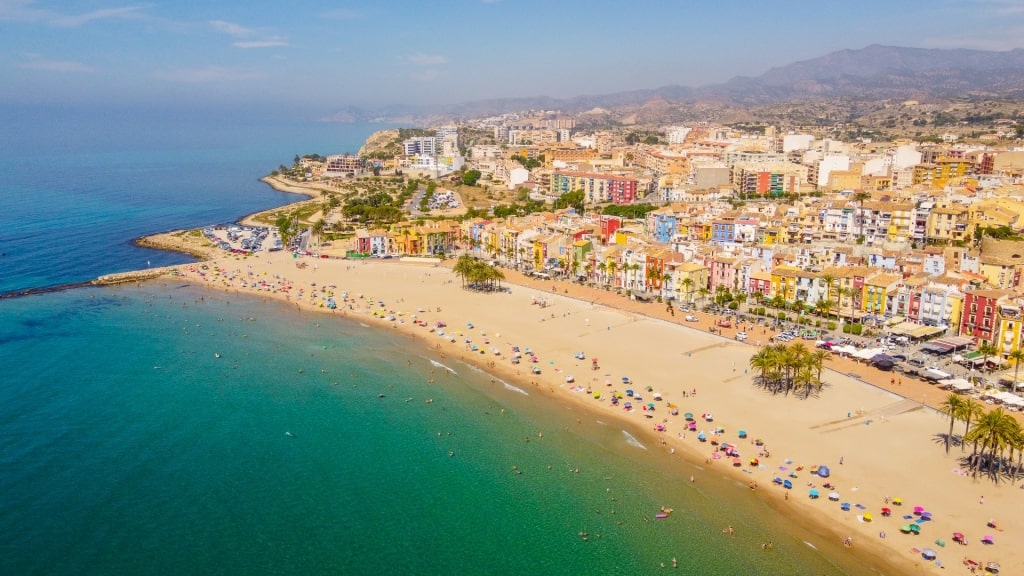
Villajoyosa
Sunbathe on a slither of the two-mile beach and enjoy a swim in the warm Mediterranean Sea and after relaxing on the soft sand, pick out a seafood restaurant from the cluster lining the promenade.
Ultra-fresh fish comes straight from Villajoyosa’s harbor and into the kitchens of restaurants Hogar del Pescador and Vilajoiosa.
Climb Monte Benacantil to Santa Bárbara Castle

Santa Bárbara Castle
One of the best things to do in Alicante is to climb Monte Benacantil to Santa Bárbara Castle for fantastic views of the city.
This sun-baked fortress has stood over Alicante since the ninth century, though it has been reconstructed by its various owners, including Philip II in the 16th century.
If you’re up for a challenge, walk to the top via the glorious Calle San Antonio. This pedestrianized street is one of the prettiest in Alicante, lined with traditional blue and white houses adorned with vibrant doorstep flower ports, cactus plants, and olive trees.

Parc de la Ereta
Take a break to soak up the views from Parc de la Ereta, overlooking El Postiguet Beach. Continue to the castle to take in the far-reaching views of the sizzling Mediterranean Sea.
You also have the option to take an elevator to the summit from Avenida Juan Bautista Lafora, opposite El Postiguet Beach.

La Torreta
Explore the castle grounds, including the upper enclosure, La Torreta. It’s here where you’ll find some of the remains of the fortress, dating back to the 14th century. Visit the Museum of the City of Alicante inside the castle, too; it traces Alicante’s past from prehistory to the present day.
Reward your climb with a feast at Restaurant L’Ereta in Parc de l’Ereta. One of the best seats on the Costa Blanca, La Ereta boasts remarkable views from the slopes of Benacantil.
Explore Biar Castle
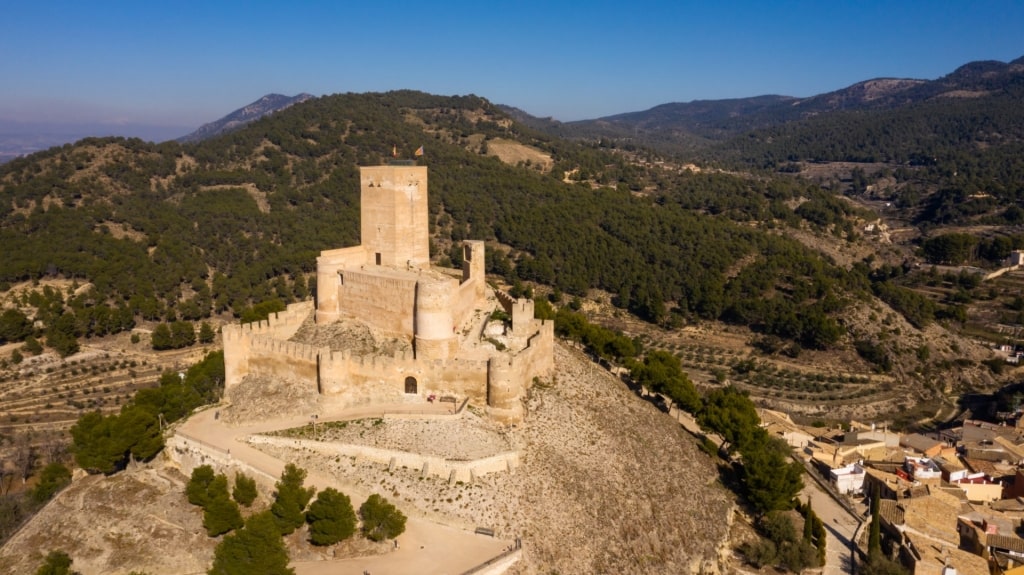
Biar Castle
Pack in 800 years of history at the 12th-century Biar Castle, 40 minutes from central Alicante, in the foothills of the Sierra Mariola.
Built by the Almohad dynasty, this hilltop fortress shares many similarities with Atalaya Castle.
Tracing the shape of the hill, Biar features a double enclosure topped with battlements, seven circular towers, and a central square tower rising above the castle walls.
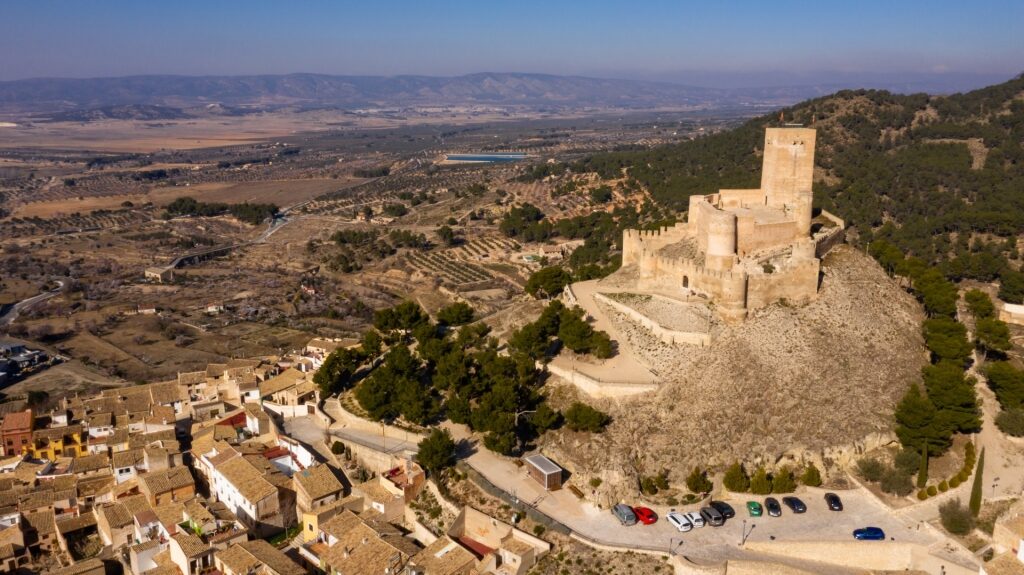
Biar Castle
On the first story of this three-floor castle, visitors will find a sublime ribbed vaulted ceiling in the traditional Almohad style. It’s the only one of its kind found in Spanish military architecture.
You can see for miles in every direction from the castle’s courtyard, including the sweeping pine forests of the Sierra Mariola and the old town’s sea of terracotta rooftops.
People-Watch in Plaza de los Luceros
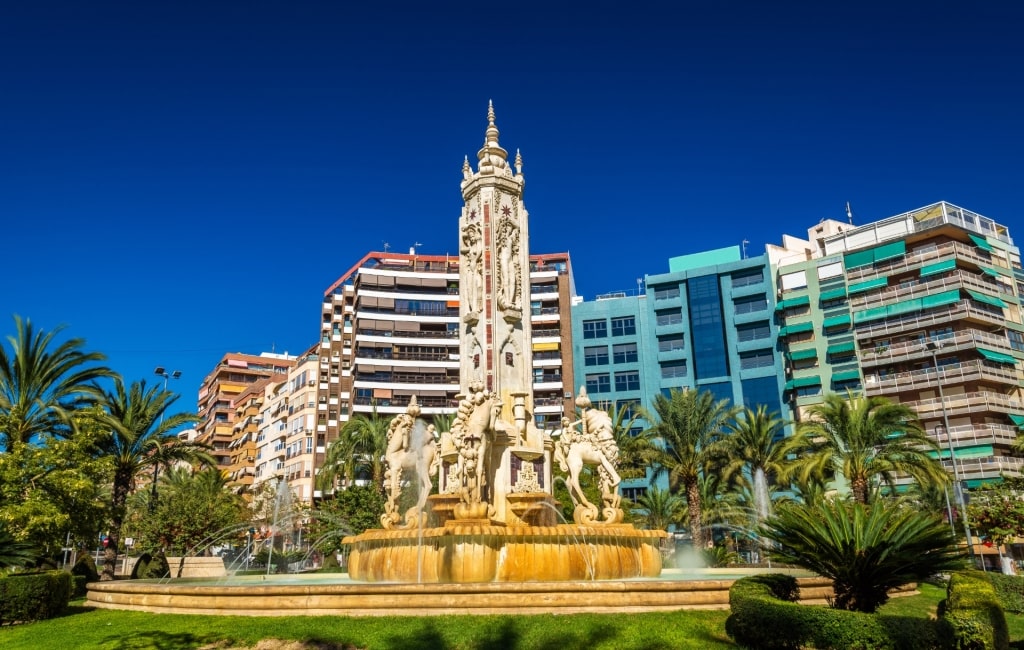
Plaza de los Luceros
Luceros, which translates as “bright stars,” is a bold public square, typical of Spain, all big palm trees and greenery, and forming a central meeting point in this beautiful Spanish city.
There’s an elegant ornamental fountain in the center of Luceros Square that’s lovely to walk around and admire. The inner path of Plaza de los Luceros is dotted with benches and among the square’s bustling outer ring are a number of places to take a seat and watch the merry-go-round of buses, trams, travelers, and city workers.
El Chaflán de Luceros has tables on the sidewalk with plenty of shaded seating to enjoy a coffee or perhaps a cocktail.
You could then walk from Luceros south along the tree-lined Avenida de Federico Soto, stopping for a spot of shopping at El Corte Inglés department store, and picking up churros from one of the street vendors before reaching Alicante’s harbor and the seafront amusement park.
Trace Alicante’s History at MARQ, the Archaeological Museum of Alicante
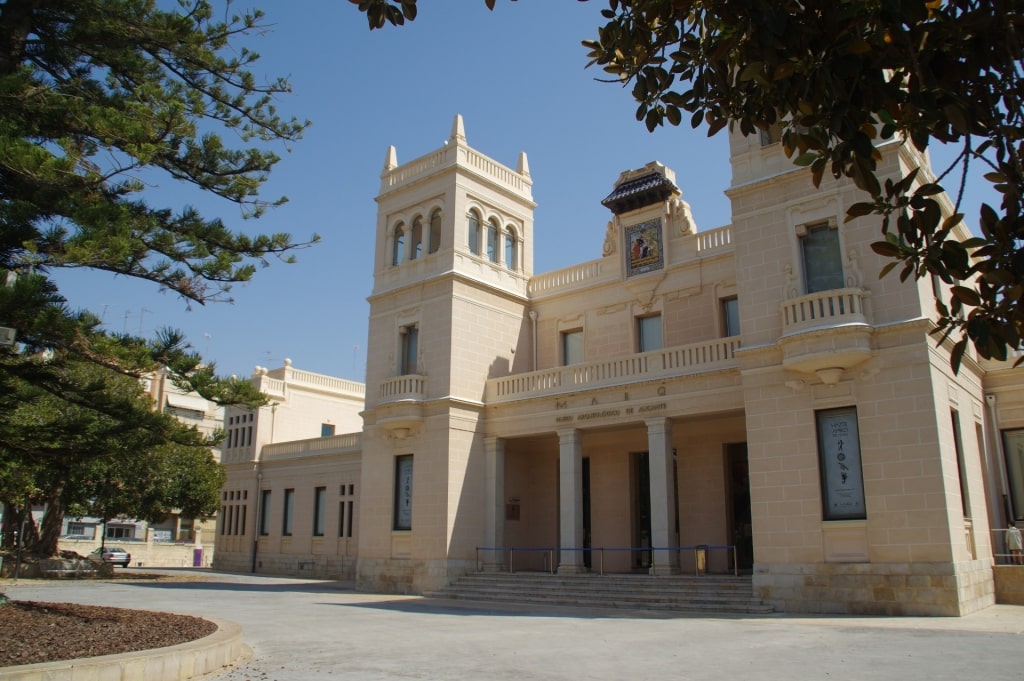
Archaeological Museum of Alicante Photo by Concepcion AMAT ORTAS on Wikimedia Commons, licensed under CC BY 3.0
Located to the northeast of Castell de Santa Bárbara, the Archaeological Museum of Alicante displays a
vast collection of treasures from as far back as 100,000 years ago, linked to three archaeological sites in the region.
These include the Sanctuary of Pla de Petracos in Castell de Castells, located roughly an hour northeast of the city and dating from the Neolithic period. Excavations began here in 1998.
The second is El Tossal de Manises, the hilltop remains of a former Roman town, Lucentum, in the east of the city, dating back to the late fourth to early fifth centuries. Here, archaeologists uncovered the remains of a Roman street plan with town walls, a forum, public baths, a sewage system, and a temple.
The third site is Illeta dels Banyets, a peninsula around an hour north of Alicante’s center that was also a Roman settlement.
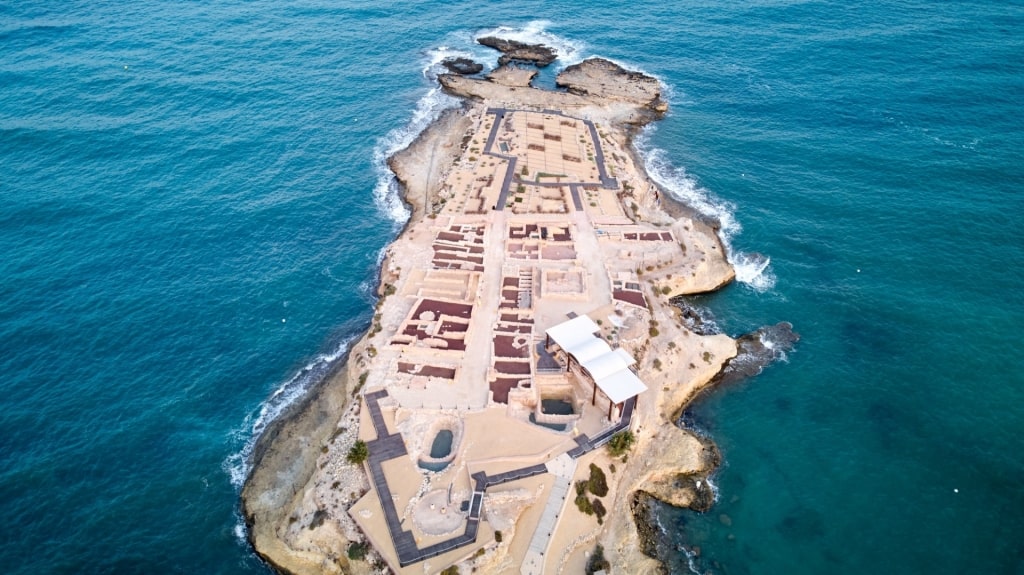
Illeta dels Banyets
Illeta dels Banyets became an islet following an earthquake that destroyed the narrow strip of land connecting it to the mainland. A road was built to reconnect it to the mainland in 1943, though sadly part of a prehistoric necropolis was destroyed in the process. The site remains of huge historical importance, harboring Bronze Age, Roman, and Islamic remains.
A visit to the Archaeological Museum or one of the three sites is one of the best things to do in Alicante for history buffs. Exhibits include items from prehistory, Iberian culture, the Roman period, and the Middle Ages, across three rooms: Field Archeology, Urban Archeology, and Underwater Archeology.
Visitors can explore a recreated Roman town, 300 objects from the Middle Ages, and ancient Iberian ceramics. However, this fascinating Spanish museum not only exhibits items, but does a fantastic job of exploring how archaeology works through revealing the techniques used to study ancient history in the field.
Shop on Calle de Las Setas
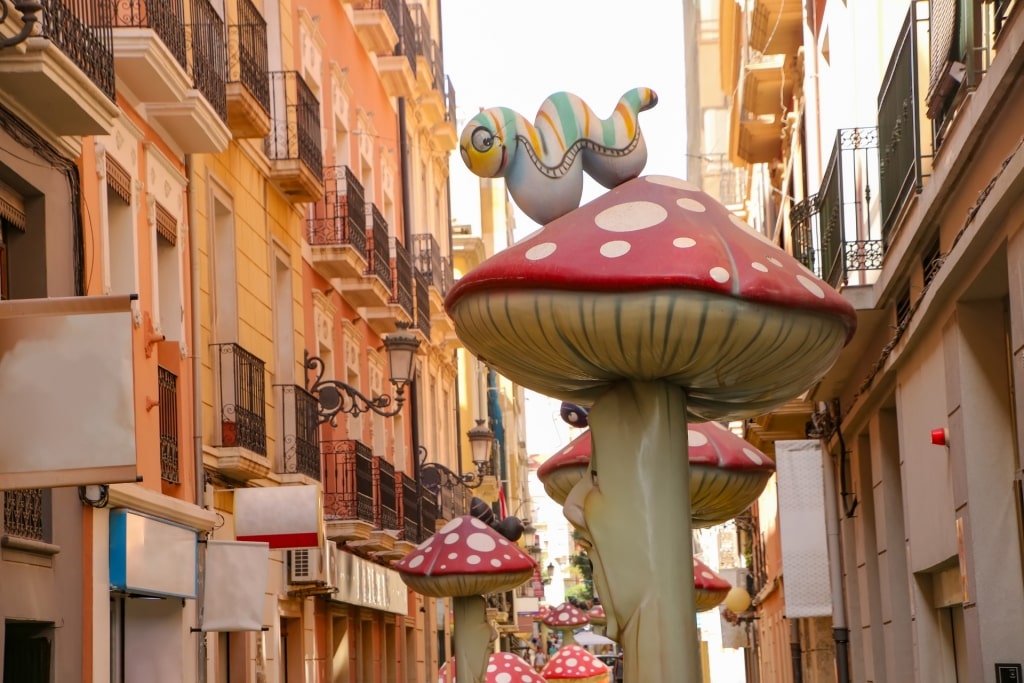
Calle de Las Setas
Calle de Las Setas, or “Mushroom Street” is a narrow pedestrian street in the center of Alicante on El Calle de San Francisco. It’s famous for being adorned with whimsical mushroom structures.
Starting from Plaza Calvo Sotelo, walk east along the yellow-brick El Calle de San Francisco to see these towering, fairytale-like toadstools lining the colorful street, until reaching Carrer Castaños.
Also known as Mushroom Esplanade, this joyous strip is lined with souvenir shops and fashion boutiques, and is a great place to shop in Alicante. The mushrooms are purely decorative, though they offer a great photo opportunity, brightening up this buzzy central stretch.
Relax in Parque El Palmeral
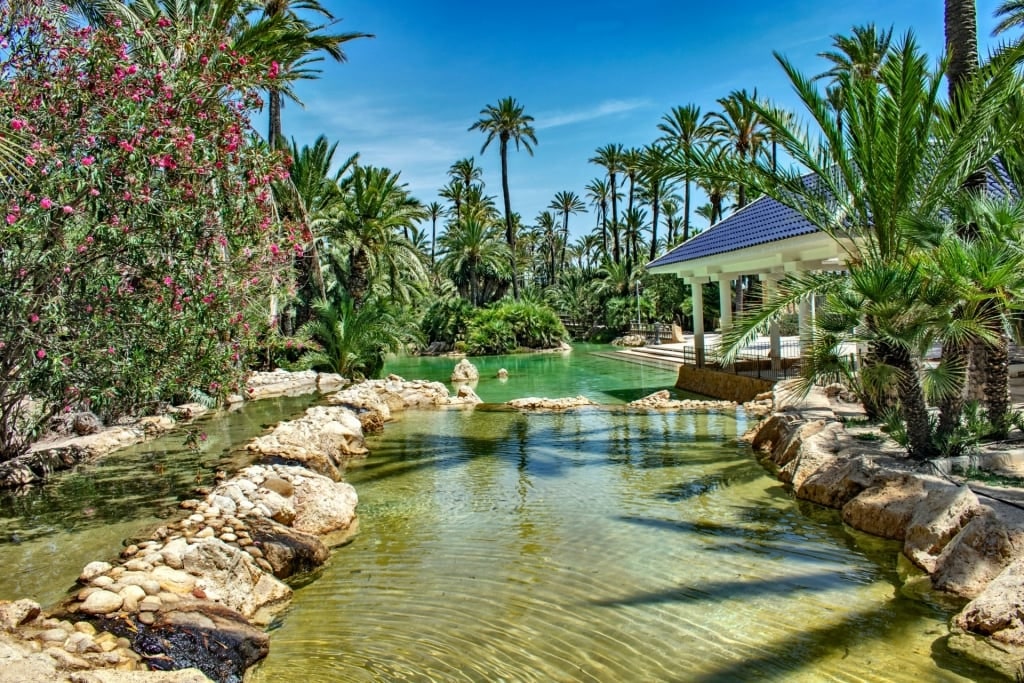
Parque El Palmeral
Scores of palm trees fill this tranquil seaside park bordering Avinguda d’Elx in the south of Alicante.
Parque El Palmeral is filled with manicured walking routes, an artificial lake, a waterfall, artificial rivers, and wooden bridges to cross. It’s a lovely leafy spot to spend a few hours and one of the best things to do in Alicante for families.
Pack a picnic and enjoy a lazy afternoon under the shade of the park’s emerald palm trees. Pick up a rowing boat and paddle in the lake. Facilities inside the park include a café and bathrooms.
Journey to Castalla Castle
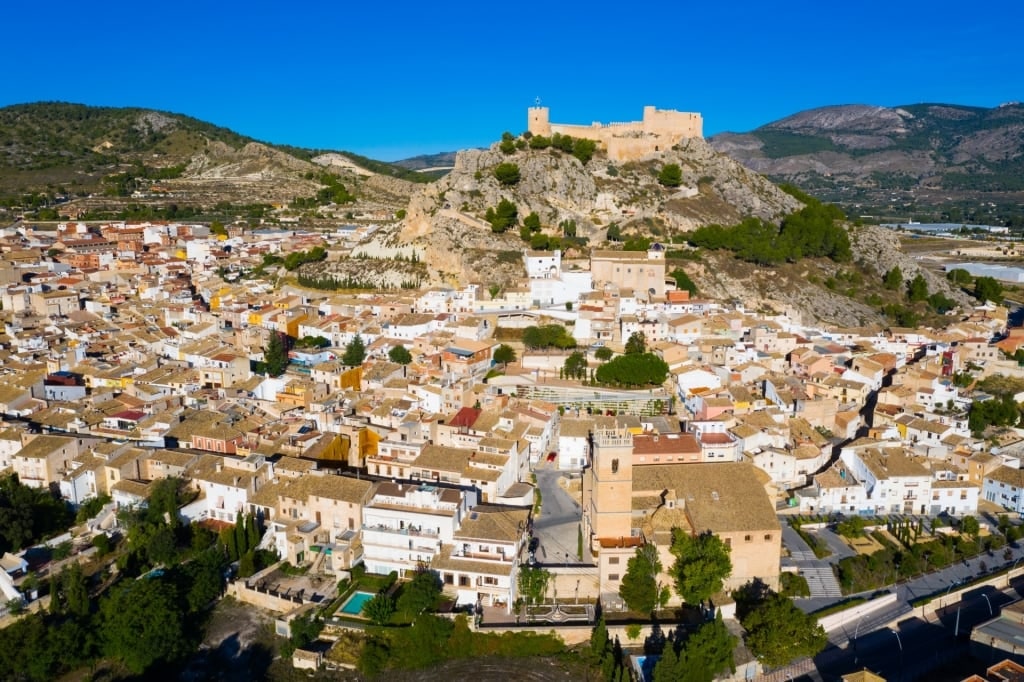
Castalla Castle
In the mountainous landscape north of Alicante, around an hour’s drive from the city, lies Castalla Castle. This hilltop fortress, overlooking the valley, is one of the best castles to visit in Spain because of its cinematic good looks.
Its lofty location, 2,559 feet above sea level, has drawn Neolithic, Bronze Age, Iberian, Roman, and Arab settlements. Today, it consists mostly of medieval structures, including battlement-topped walls that trace the rugged honey-colored terrain and circular towers.
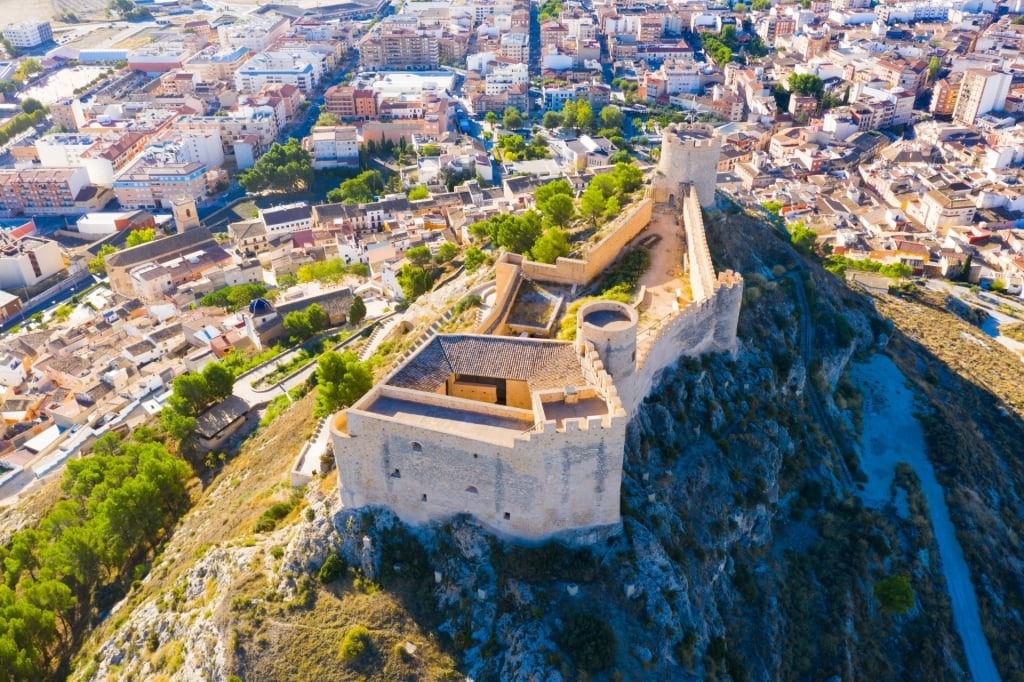
Castalla Castle
Inside, there’s a parade ground, a palace, and the Torre Grossa tower. Added in 1579, Torre Grossa was built as a look-out point to protect the castle against Berber pirate raids.
It’s worth joining a guided tour of Castalla Castle, which takes place throughout the year. The views from the castle are spectacular and you’ll be treated to an enriching history lesson at the same time.
Tour Alicante Bullring
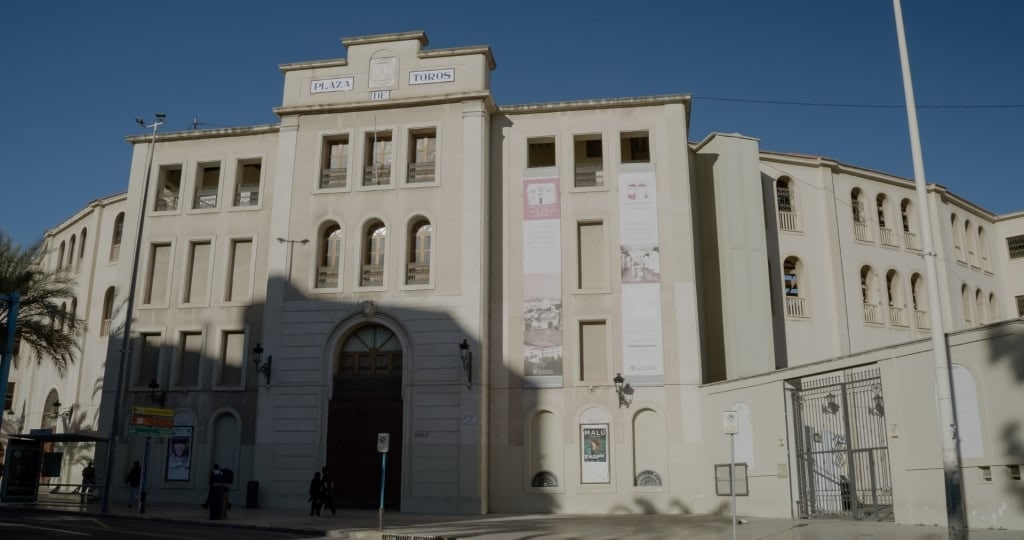
Alicante Bullring
While bullfighting isn’t to everybody’s taste, visiting Alicante Bullring is one of the best things to do in Alicante to gain an insight into this controversial Spanish tradition that’s so deeply embedded in the culture.
Designed by architect José Guardiola Picó, Alicante Bullring was completed in 1888 and is one of Spain’s largest, featuring horseshoe arches and decorative columns. The tiered circular arena holds 11,600 spectators and while it continues to hold the occasional bullfights, it’s also used for events and concerts.
Alicante Bullring is also home to the Bullring Museum, where a collection of costumes, including capes and monteras (a type of hat worn by bullfighters) are on display, alongside other paraphernalia. The museum also charts the history of bullfighting and its place in Spanish culture.
Visit the Ocean Race Museum
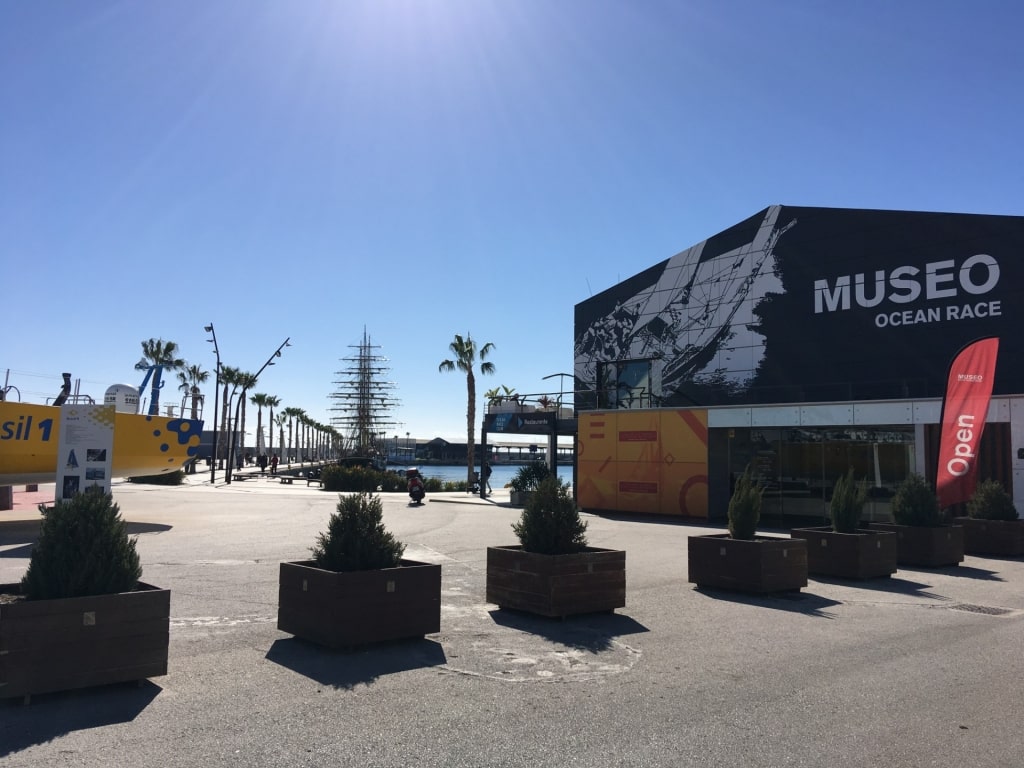
Ocean Race Museum Photo by Museo The Ocean Race on Wikimedia Commons, licensed under CC BY-SA 4.0
Alicante’s Ocean Race Museum shines a lens on ocean regattas with a specific focus on The Ocean Race. This around-the-world yacht race spans 32,000 nautical miles, starting in Alicante and ending in Genoa, Italy.
The race has been held every few years since 1973, taking in destinations such as South Africa, Brazil, the United States, and Denmark.
This epic race sees teams of around 10 crew compete around the clock for around 20 days over the course of 10 or more legs. The museum reveals fascinating details such as rules of the race and the conditions crew face while sailing.
Visitors can explore the history of this revered regatta, see photos and videos taken during races, and test out The Ride, a simulator experience to understand what it feels like to bash through waves of 25 to 30-knots.
On a guided tour, visitors can also board the slender Brasil 1, a Volvo 70 vessel that participated in the 2005-06 Ocean Race.
After exploring the museum, enjoy a walk along the harbor and stop for a bite to eat at Ocean Race Club restaurant. The museum’s restaurant has a lovely outdoor terrace and tasty Mediterranean menu, featuring dishes such as carpaccio of sea bass and octopus with aioli paprika.
Stop by the Bonfire Museum
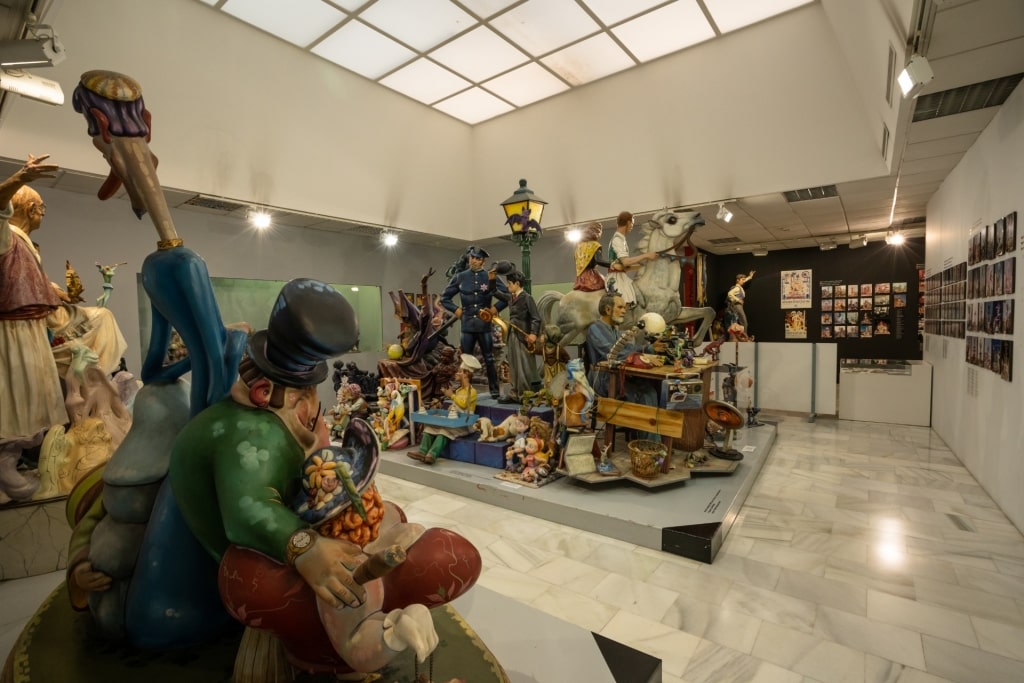
Bonfire Museum
Alicante’s Bonfire Museum, or the Fogueres Museum, is dedicated to Les Fogueres de Sant Joan (the Bonfires of St. John), the city’s most important annual festival that’s celebrated every June.
This religious festival has evolved from the tradition of St. John’s Eve, the eve of the feast day of St. John the Baptist, which marks the saint’s birthday on June 24. Celebrations traditionally involve bonfires, feasting, church services, processions, and general merriment.
At the museum, you’ll get to explore the origins of Les Fogueres de Sant Joan through videos, photos, and costumes. A highlight is seeing the intriguing Ninots Indultats, large effigies that are spared from the bonfires based on their special merits or beauty.
Hike the Argueña Mountains & Maigmó Massif

Sierra del Maigmó
Between the Vinalopó valley to the west and the Foia de Castalla to the east lie the Argueña mountains and the Maigmó massif, just a 45-minute drive northwest of Alicante.
The pine and oak-covered Maigmó massif rises an impressive 4,252 feet, its towering pinnacle giving it the name the Balcony over Alicante. The Argueña Mountains and Maigmó massif offer plenty of hiking routes to suit different abilities.
Replana de la Font del Llop is a hiking loop within the Argueña mountains that reaches a height of just over 4,000 feet, offering some of the most spectacular mountain views in southeast Spain.
Top-tier trails are also found around Tibi Dam at the foot of Maigmó’s peak. This masonry dam dates from the 16th century, making it one of the oldest non-Roman dams in Europe. Almost 500 years on, it remains in excellent working order.

Mistle thrush
Keep an eye out for the birdlife darting among the pines, including crossbill, mistle thrush, jay, and woodlark. You might also spot wild boar roaming the forests.
When hiking, wear practical footwear—ideally hiking boots—and carry water, sunscreen, and food to enjoy a picnic.
Take a Day Trip to Murcia
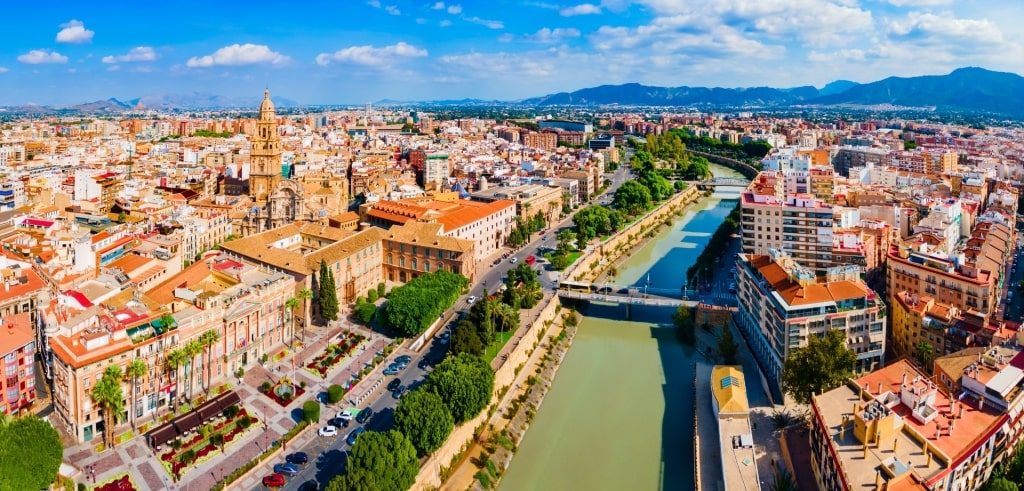
Murcia
Murcia, with its ornate cathedral, modern city hall, and elegant squares, is an easy day trip from Aliante. The best way to reach Murcia from this seaside city is by rail, hopping on a direct train, which takes around 55 minutes.
Make it your priority to visit the city’s showpiece Murcia Cathedral. A gorgeous baroque landmark, this lavish cathedral was built in the 15th century and is home to the second-tallest bell tower in Spain.
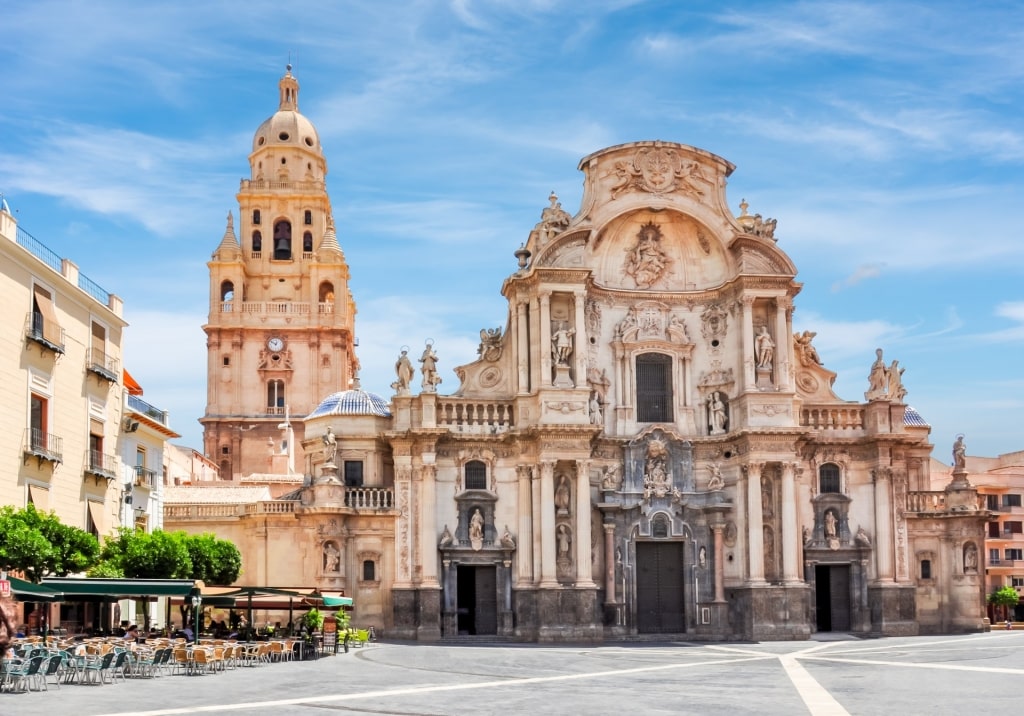
Murcia Cathedral
Next, spend time in Plaza del Cardenal Belluga for the best views of the cathedral’s front facade. The handsome, red-fronted Episcopal Palace of Murcia, headquarters of the Diocese of Cartagena and built in the early 18th century, is also located here.
Plaza de las Flores is another beautiful square to visit, and the perfect spot to enjoy a glass of something chilled at one of the cafés or bars lining the plaza.
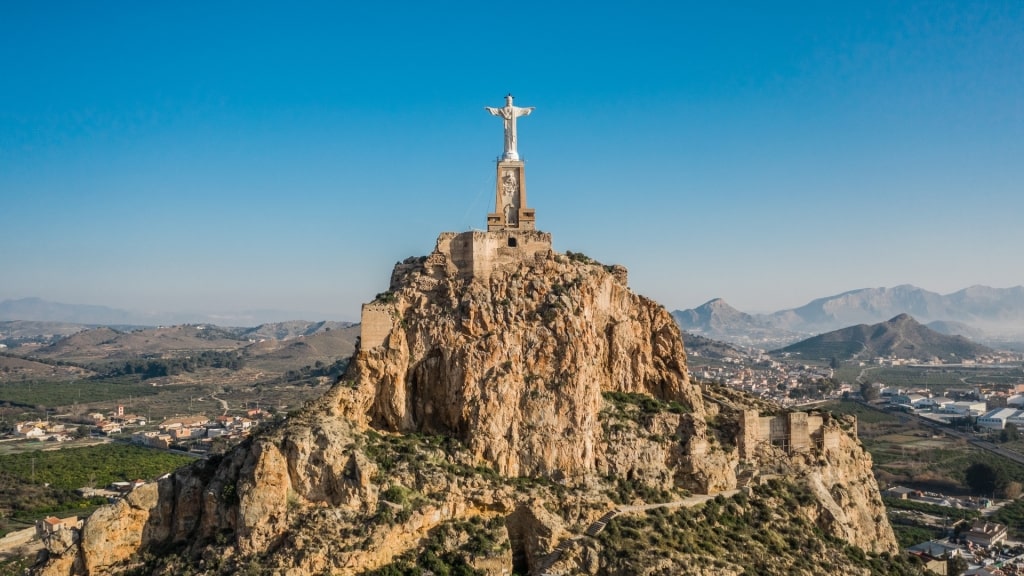
Castillo de Monteagudo, Murcia
If you’ve time, factor in a visit to the ninth-century Castillo de Monteagudo, which stands on a natural, rugged limestone plinth on the northern edge of the city. It’s known for its gleaming statue of Christ, reminiscent of Rio de Janeiro’s Christ the Redeemer. Built in 1926, Cristo de Monteagudo was rebuilt 1951 after being destroyed during the Spanish Civil War.
Go Bird Watching in El Fondo Nature Reserve
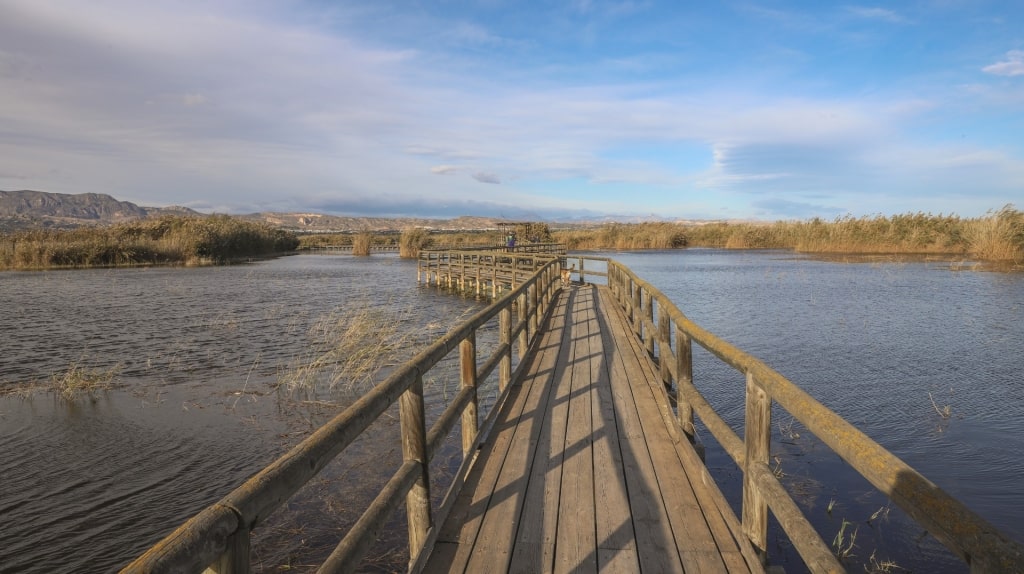
El Fondo Nature Reserve
A short drive southwest of Alicante, at the mouth of the Vinalopó and Segura rivers, nature-filled wetlands form El Fondo Nature Reserve (or Parque Natural de El Hondo) near Elche.
The park is made up of lagoons, salt marshes, thickets of reed, and clusters of palm trees, creating a truly idyllic setting that is thoroughly deserving of its Area of Outstanding Natural Beauty designation. There are 172 bird species in El Fondo, with around 50 types of nesting birds, including flamingos, herons, and wading ducks.
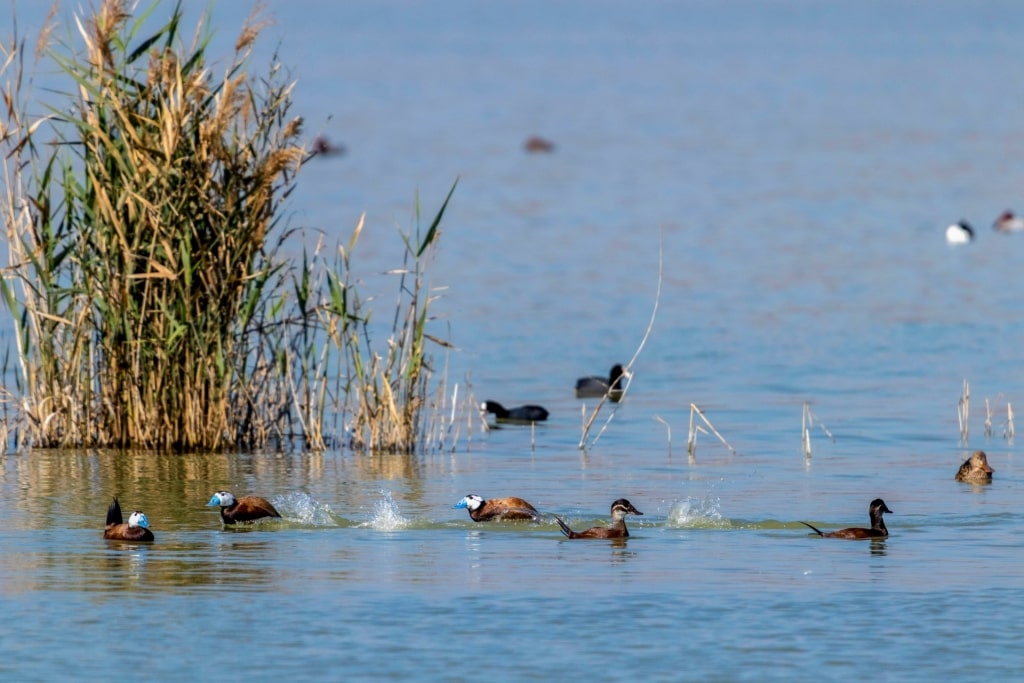
Ducks in El Fondo Nature Reserve
The white-headed duck and marbled teal, two of Europe’s most threatened species, are also found here, and the waters harbor the endemic toothcarp, as well as mullets and eels.
The park is also a fantastic place to source marsh samphire and sea lavender; both are edible sea vegetables.
Spend time at the visitor center to learn about El Fondo’s diverse wildlife before meandering along the wooden walkways to an observation point. Pack binoculars to gain a better view of feeding flamingos and swooping greater spotted eagles.
Make a Pilgrimage to Santa Faz
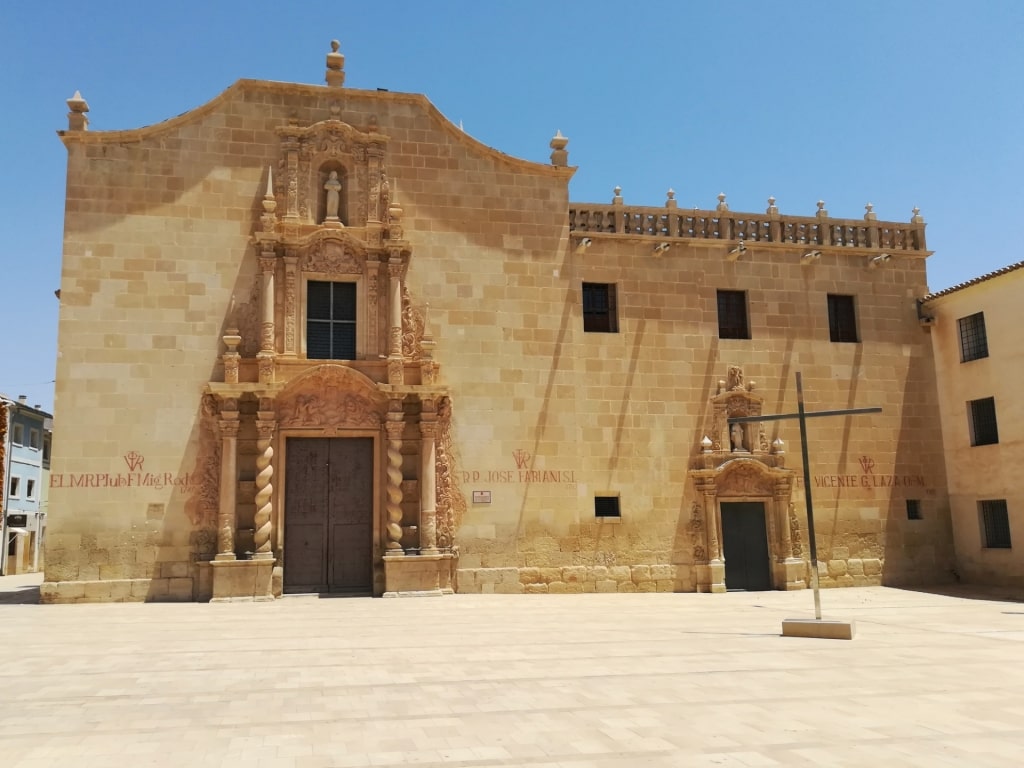
Santa Faz Monastery
Not all of the best things to do in Alicante are in the center of this Spanish city. In Santa Faz, a short drive northeast, there is a caramel-colored monastery that’s also known as the Monastery Sanctuary of the Holy Face.
This unassuming baroque monastery receives pilgrims keen to witness the Holy Face of Alicante, a relic brought here in 1489 that is said to be a veil used by Jesus to wipe his bloodied face.
It’s displayed behind the main altarpiece in a special room. The piece of cloth, also known as the veil of Veronica as it said that St. Veronica gave Jesus the cloth, features what is widely considered to be the outline of the face of Jesus.
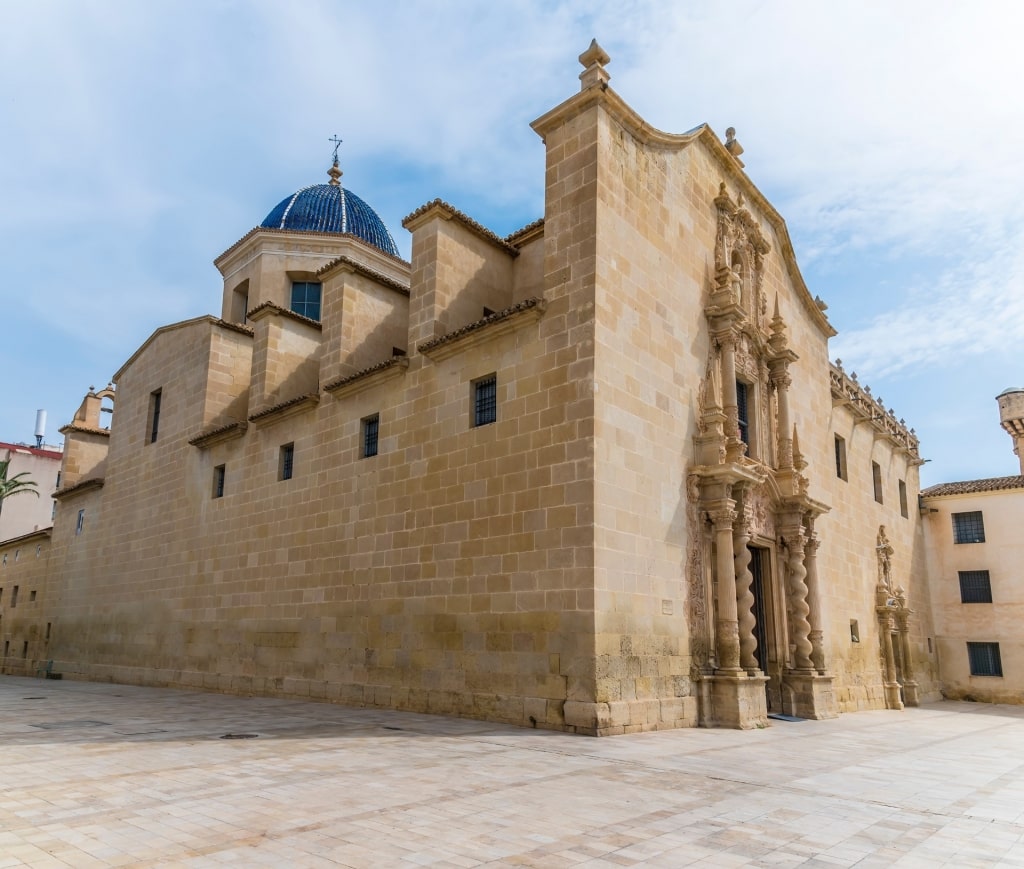
Santa Faz Monastery
The official Peregrina de la Santa Faz pilgrimage takes place annually on the second Thursday following Easter Sunday and sees thousands of pilgrims make the five-mile journey from Alicante to Santa Faz.
Visit the monastery and enjoy a stroll around the small sun-drenched town, with its pretty watercolor buildings and a traditional tapas bar serving plates of smoked sardines, red shrimps, and potato omelet.
Read: Spain Travel Tips
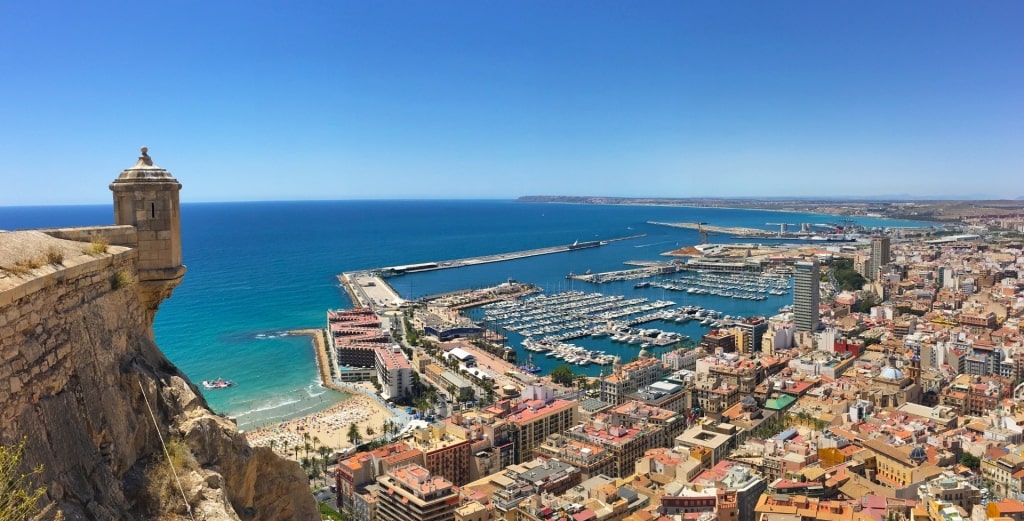
Alicante
Explore Alicante’s fabulous beaches, rich gastronomy, and layers of culture on a voyage to Spain. Browse Celebrity’s Alicante cruises to plan your next European getaway.
